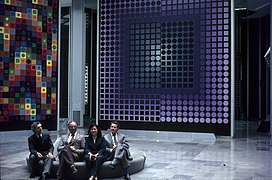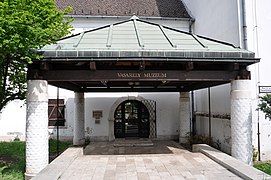Victor Vasarely
Victor Vasarely ( Hungarian : Vásárhelyi Győző ; born April 9, 1906 in Pécs , † March 15, 1997 in Paris ) was a French painter and graphic artist of Hungarian descent . He is one of the co-founders of the artistic direction Op Art .
Life
Victor Vasarely studied at the Podolini-Volkmann Academy in Budapest . Later he attended the Mühely School of Graphics, run by Sándor Bortnyik in the tradition of the Bauhaus.
In 1930 he moved to Paris, where he worked as a commercial artist between 1930 and 1940 , mainly designing posters . He developed an interest in trompe-l'œil ( French: "fool the eye"), graphic patterns and illusions of space.
From 1944 he devoted himself exclusively to painting. This year he exhibited for the first time in the Denise René gallery in Paris. Here, in addition to chessboard and conflicting patterns, he also showed figurative motifs. From 1947 Vasarely concentrated on constructive geometric, abstract motifs.

In the 1950s he developed his kinetic art program . In his Yellow Manifesto ( Manifest Jaune ) for the group exhibition Le Mouvement at Denise René (1955), he called for the work of art as a prototype - with the properties of repeatability as serial reproducibility and the applicability of its forms beyond art. He fulfilled these requirements: His own pictures and sculptures are now characterized by the aggressive interplay of standardized basic shapes and colors, which are put together in different ways to create patterns. From 1961 he lived in Annet-sur-Marne .
Victor Vasarely won numerous international art awards in 1965 and 1967. He was a participant in documenta 1 (1955), documenta II (1959), documenta III (1964) and also the 4th documenta in 1972 in Kassel . In 1972 he developed a new op-art- style diamond logo for the Renault automobile company .
Vasarely received the Guggenheim Prize in New York in 1964. He was made Knight of the Order for Art and Literature in Paris in 1965. Other prizes were: Grand Prize of the VIII Biennale of São Paulo , 1970 nomination as Knight of the Legion of Honor .
His son Jean Pierre (1934-2002) became known as an artist under the name of Yvaral .
Victor Vasarely died in Paris in 1997 after suffering from cancer.
plant
His first major work Zebra is today considered the first work of Op Art and Vasarely as a co-founder of this direction. The formal vocabulary of his artistic work includes square, rhombus, triangle, circle and rod shape. He consistently used kinetic effects and optical phenomena.
His work is characterized by different periods, which sometimes ran parallel or overlapped. Well-known works come mainly from the following periods:
- Noir-Blanc period (1955–1963), in which he played with the contrast between the colors white and black
- Hommage à l'hexagone (1964–1972), in which he uses light and dark effects to create perspectives that are physically impossible.
- Universal structures - Vega (from 1969), in which he deforms a regular grid in such a way that it optically leaves the two-dimensional space. The structures and color effects vary depending on the light irradiation and light color.
Important individual works:
- 1957: Markeb-Neg
- 1968: Vega 200
- 1969: PAUK-SP
- 1969/1970: Pal - 5 , 200 × 200 cm
- 1970: Vaar
- 1978: Gestalt-Rugó
In addition to the multi-layered graphic, painterly and sculptural works, an important concern of Victor Vasarely is to make a contribution to the design of building facades and to the systematization of artistic work. His “plastic alphabet” is a closed canon of basic shapes and colors. The basic shape is again the square. It is combined with a circle, ellipse, rectangle, diamond or triangle. Six basic colors are assigned. This results in endless combinations of shapes and colors that lead to the three-dimensional units.
In 1963 Vasarely presented the “Plastic Alphabet” to the public for the first time under the title “Folklore Planetaire”. In the Musée des Arts Décoratifs in Paris, the museum for applied arts, the diverse possibilities of this system quickly become clear: In addition to paintings and prints, Vasarely also designs wallpapers, fabrics and furniture.
Vasarely's “Plastic Alphabet” reacts to the monotonous urban development, he would like to contrast the dreary gray residential areas with the “Colored City”. The "Cité polychrome" should not be limited to the design of facades, it should also be included in the plastic, architectural design of buildings and cities. In the Fondation Vasarely in Aix-en-Provence, completed in 1976, the artist can demonstrate his educational ideas.
"The first activity of our foundation will be to prove that the large building complexes could be much nicer and more comfortable if basic aesthetic rules, taste and love had been integrated into their volume."
The Fondation's building is designed to provide workplaces for artists, architects and town planners, and at the same time offers ample, monumental space for the presentation of Vasarely's art.
Facade of the Bonn Juridicum (Photo: 2005)
Vasarely sculpture in Pecs , Hungary
Sculpture at the South Railway Station in Budapest (Déli Pályaudvar)
Museums and institutions
In 1970 Vasarely founded a museum with his own work at the Château de Gordes . It was closed in 1996 after disputes and bankruptcy.
In 1976 the Vasarely Foundation was established in Aix-en-Provence . 46 monumental works as well as working studies on their creation are exhibited there. The concepts for the “plastic alphabet” are shown in 22 showcases.
Also in 1976 the Vasarely Museum opened in the Hungarian city of Pécs in the house where the artist was born.
In 1978 the Vasarely Center was opened in New York.
In 1987 the Vasarely Museum opened in Zichy Castle in Budapest.
Logo of the Vasarely Foundation in Aix-en-Provence
Vasarely Museum in Pécs
literature
- Anneke Bokern: Polychromy and happiness: The Vasarely Foundation in Aix-en-Provence, 1973–76 . In: Bund Schweizer Architekten (ed.): Werk, Bauen + Wohnen . tape 95 , no. 7-8 . Zurich 2008, p. 22-29 , doi : 10.5169 / seals-130835 .
- Jürgen Claus: An architectural art: Victor Vasarely , in: Jürgen Claus: Kunst heute , rowohlts deutsche enzyklopädie, 238/239, Rowohlt Verlag, Reinbek near Hamburg, 1965
- Manfred de la Motte, Alexander Tolnay: Vasarely. Works from six decades , Klett-Cotta, Stuttgart 1986, ISBN 3-608--76217-5
- Magdalena Holzhey: Victor Vasarely: 1906–1997. Pure seeing , Taschen-Verlag, Cologne, 2018, ISBN 978-3-8228-3905-8
Quotes
"A picture must be made to which the magician cannot add anything more and take anything away."
“Our aim can only be aesthetic. We will endeavor to
1. announce the choice we have made about the theory of plastic functions
2. to ensure that the plastic alphabet is used . This includes:
a) formal unit,
b) a method on a binary basis,
c) the use of our eleven color scales with 22 shades, from white to black,
d) the interchangeability of our form and color units
e) the programming of banal structures into strict compositions,
f) the use of our parameters and our tried and tested grids: the chessboard, the equilateral triangle, the rhombus, the hexagon, the axonometric hexagon and the octagon; ... "
"Art is artificial and by no means natural: To create does not mean to imitate nature, but to equal it and even surpass it by means of an invention of which only humans are capable of living."
In later years he criticized the developments within abstract art with the familiar words:
“Art has become a no man's land. Everyone can call themselves an artist or even a genius. Every stain of paint, every scratch and every scratch can be declared a work of art in the name of sacred subjectivism. "
Exhibitions
- 2009/2010: Victor Vasarely + 50 years of constructive art in Paris , kunsthalle messmer , Riegel am Kaiserstuhl .
- 2018/2019: Victor Vasarely. In the labyrinth of modernity , Städel , Frankfurt am Main
- 2019: Vasarely. Le Partage des Formes, Center Pompidou , Paris
Web links
- Literature by and about Victor Vasarely in the catalog of the German National Library
- Materials by and about Victor Vasarely in the documenta archive
- Vasarely Foundation
- Association des amis de la Fondation Vasarely
Individual evidence
- ↑ Victor Vasarely . ( Memento of the original of July 24, 2011 in the Internet Archive ) Info: The archive link was automatically inserted and not yet checked. Please check the original and archive link according to the instructions and then remove this notice. Association Vasarely - Aix-en-Provence
- ↑ Karin Thomas: Until today. Style history of the fine arts in the 20th century. DuMont, Cologne 1979, p. 239.
- ↑ Died: Victor Vasarely . In: Der Spiegel . No. 13 , 1997, pp. 234 ( online ).
- ^ Roberta Smith: Victor Vasarely, Op Art Patriarch, Dies at 90 . ( nytimes.com [accessed October 4, 2018]).
- ^ Robert Waterhouse: Sad end of a dazzling life . In: The Guardian . March 17, 1997, p. 13 .
- ^ A b Victor Vasarely: Farbstadt = Cité polychrome . Ed .: Contribution by Eugen Gomringer and texts by the artist to the Fondation Vasarely in Aix-en-Provence. Munich 1977.
- ^ Victor Vasarely in the Städel Museum. Retrieved on October 1, 2018 (digitorial for the exhibition with further information on the artist and work).
- ^ Expositions - Center Pompidou. Retrieved February 8, 2019 .
| personal data | |
|---|---|
| SURNAME | Vasarely, Victor |
| ALTERNATIVE NAMES | Vásárhelyi, Győző; Vasarely, Victor von (stage name) |
| BRIEF DESCRIPTION | French painter and printmaker |
| DATE OF BIRTH | April 9, 1906 |
| PLACE OF BIRTH | Pécs |
| DATE OF DEATH | March 15, 1997 |
| Place of death | Paris |






